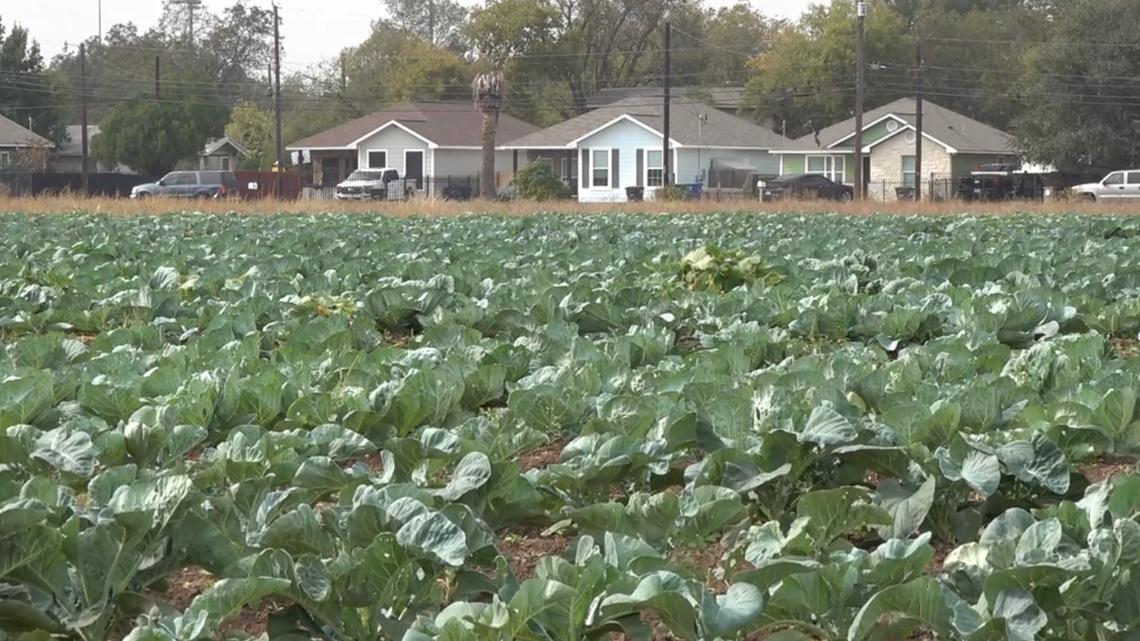The San Antonio Food Bank has added new crops to their historic west-side farm.
SAN ANTONIO — Butterflies flit in the breeze, enjoying the blooms in a working farm that offers a window to the past and the future.
The San Antonio Food Bank operates a robust 25-acre farming operation on the city’s west side, on land once owned by the Van de Walle family.
The Belgium immigrants were known far and wide for their vegetable crops.
Now, that space is growing into the future, nurtured along by urban farmers who are still producing food and bringing life to the Food Bank motto: “Fighting Hunger & Feeding Hope.”
The green growing guru who oversees the operation is Mitch Hagney, the group’s director of food resilience.
“We’re proud to be able to farm on historic farmland at what used to be the Van de Walle Farms,” Hagney said. “This is the same soil that’s been nourishing this community for over 100 years, and we’re very proud to continue that tradition and (be) feeding as many folks as we can.”
Speaking with fondness and pride in the mission, which is expanding now with non-traditional crops for the industry, Hagney said, “Our farm here at the San Antonio Food Bank is the largest urban farm in Texas, and we are very excited to be able to expand our offerings from typical vegetables that we have—root veggies, cabbages. We’re beginning to offer leafy greens that we’re distributing to the public.”
Hagney said the leafy greens they are starting to produce are exactly the kind of help local families need, especially now.
“Leafy greens are one of the most nutritious things you can put on the table,” he said. “We’re growing things like kale, collard greens, Swiss chard, lettuces, spinaches, other things that are very challenging for food banks to get because they have such a short shelf life. So we figured, why don’t we just grow them ourselves?”




Hagney said that, in a world where shelf-stable, non-perishable offerings are the norm, being able to give greenery is an amazing accomplishment.
“Something we’re very proud of at the food bank is about a third of all of our offerings are produce. They have all this great vitamin content and we think that those are one of the best things to be able to put on your table,” Hagney said.
Hagney said in addition to variety, he’s proud of the way they manage the operation.
“All of it is organic, so we use no herbicides. As a result, we know that we’re distributing the highest possible quality product to the neighbors,” he added. “And the volunteers and other folks that come and help us, they can feel safe and content as they’re helping us produce these crops.”
Volunteers, Hagney said, are a vital part of the effort.
“The San Antonio Food Bank could not function without volunteers. We will serve about 110,000 people every week, and the only way that we’re able to do that is with community buy-in. Folks can come and help us cook. They can help us sort. They can help us distribute, but what I love is when people come and help us on the farm,” Hagney said, adding that all ages are welcome.
“They get their hands a little bit dirty in the process and they learn about agriculture,” Hagney said, while explaining that people with enthusiasm and a willingness to learn are the heart of the operation.
Volunteers learn by doing. Hagney said the crops in the field now include cold weather crops.
“In the summertime we grow some other exciting crops, things like tomatoes, melons, peppers, eggplant,” Hagney said. “There’s always something that’s coming out of the ground in San Antonio because we have a year-long growing season. It gets very hot, but as a result, we have a very productive winter.”
Constantly smiling as he moves between rows of bounty, Hagney said: “For me, being able to converge sustainable agriculture, revisiting some of our roots while trying to nourish the community, there’s no other job that I would rather have than being out here in the fields connecting to neighbors every day.”
It’s a love he is paying forward into the future.
“We distribute food every day, but our goal is to help provide food today, food tomorrow and food for a lifetime,” he said. “This farm is part of that strategy to try to build up food resilience for the community for an entire lifetime.”
More information about how to volunteer can be found here.
